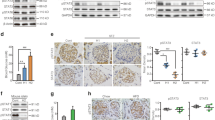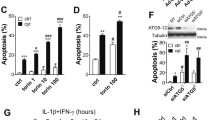Abstract
Phosphatase and tensin homolog (PTEN), a tumor suppressor gene, by negatively regulating the PI3K-Akt signaling pathway, participates in multiple biological processes such as cell proliferation, apoptosis, differentiation, and migration. Recent studies show that selective deletion of PTEN in pancreatic β-cells leads to resistance to streptozotocin (STZ)-induced diabetes, but the mechanism is unclear. One major mechanism underlying STZ toxicity is cytokine-mediated β-cell destruction in which oxidative stress plays a key role. The present study investigated the role of PTEN in cytokine-induced β-cell apoptosis, and further explored whether oxidative stress, particularly peroxynitrite formation, could regulate PTEN-Akt pathway. Incubation of βTC-6 cells with cytokine mixture (IL-1β, TNF-α, and IFN-γ) or exogenous peroxynitrite significantly increased apoptotic cell percentage, elevated PTEN and p-PTEN levels, and inhibited Akt activation. Transfection with PTEN-specific siRNA protected βTC-6 cells from cytokine or peroxynitrite-mediated cell apoptosis and partially reversed Akt inhibition. Furthermore, nitrotyrosine formation, an indicator of peroxynitrite production, was significantly elevated after cytokine treatment. Preventing peroxynitrite formation by administrating NAC/l-NMMA, or scavenging peroxynitrite directly by UA, attenuated cytokine-induced PTEN upregulation, Akt inhibition, and β-cell apoptosis. These findings suggest that peroxynitrite-mediated PTEN upregulation plays an important role in cytokine-induced pancreatic β-cell apoptosis.








Similar content being viewed by others
References
Baker SJ (2007) PTEN enters the nuclear age. Cell 128:25–28
Tell G, Pines A, Arturi F et al (2004) Control of phosphatase and tensin homolog (PTEN) gene expression in normal and neoplastic thyroid cells. Endocrinology 145:4660–4666
Wijesekara N, Konrad D, Eweida M et al (2005) Muscle-specific Pten deletion protects against insulin resistance and diabetes. Mol Cell Biol 25:1135–1145
Stiles B, Wang Y, Stahl A et al (2004) Liver-specific deletion of negative regulator Pten results in fatty liver and insulin hypersensitivity [corrected]. Proc Natl Acad Sci USA 101:2082–2087
Kurlawalla-Martinez C, Stiles B, Wang Y, Devaskar SU, Kahn BB, Wu H (2005) Insulin hypersensitivity and resistance to streptozotocin-induced diabetes in mice lacking PTEN in adipose tissue. Mol Cell Biol 25:2498–2510
Tong Z, Fan Y, Zhang W et al (2009) Pancreas-specific Pten deficiency causes partial resistance to diabetes and elevated hepatic AKT signaling. Cell Res 19:710–719
Stiles BL, Kuralwalla-Martinez C, Guo W et al (2006) Selective deletion of Pten in pancreatic beta cells leads to increased islet mass and resistance to STZ-induced diabetes. Mol Cell Biol 26:2772–2781
Amirshahrokhi K, Dehpour AR, Hadjati J, Sotoudeh M, Ghazi-Khansari M (2008) Methadone ameliorates multiple-low-dose streptozotocin-induced type 1 diabetes in mice. Toxicol Appl Pharmacol 232:119–124
Fukuda K, Tesch GH, Nikolic-Paterson DJ (2008) c-Jun amino terminal kinase 1 deficient mice are protected from streptozotocin-induced islet injury. Biochem Biophys Res Commun 366:710–716
Holohan C, Szegezdi E, Ritter T, O’Brien T, Samali A (2008) Cytokine-induced beta-cell apoptosis is NO-dependent, mitochondria-mediated and inhibited by BCL-XL. J Cell Mol Med 12:591–606
Abdelli S, Puyal J, Bielmann C et al (2009) JNK3 is abundant in insulin-secreting cells and protects against cytokine-induced apoptosis. Diabetologia 52:1871–1880
Ortis F, Pirot P, Naamane N et al (2008) Induction of nuclear factor-kappa B and its downstream genes by TNF-alpha and IL-1 beta has a pro-apoptotic role in pancreatic beta cells. Diabetologia 51:1213–1225
Chambers KT, Unverferth JA, Weber SM, Wek RC, Urano F, Corbett JA (2008) The role of nitric oxide and the unfolded protein response in cytokine-induced beta-cell death. Diabetes 57:124–132
Barbu A, Welsh N, Saldeen J (2002) Cytokine-induced apoptosis and necrosis are preceded by disruption of the mitochondrial membrane potential (Deltapsi(m)) in pancreatic RINm5F cells: prevention by Bcl-2. Mol Cell Endocrinol 190:75–82
Suarez-Pinzon WL, Szabo C, Rabinovitch A (1997) Development of autoimmune diabetes in NOD mice is associated with the formation of peroxynitrite in pancreatic islet beta-cells. Diabetes 46:907–911
Suarez-Pinzon WL, Mabley JG, Strynadka K, Power RF, Szabo C, Rabinovitch A (2001) An inhibitor of inducible nitric oxide synthase and scavenger of peroxynitrite prevents diabetes development in NOD mice. J Autoimmun 16:449–455
Rabinovitch A, Suarez-Pinzon WL, Sooy K, Strynadka K, Christakos S (2001) Expression of calbindin-D (28 k) in a pancreatic islet beta-cell line protects against cytokine-induced apoptosis and necrosis. Endocrinology 142:3649–3655
Lee SR, Yang KS, Kwon J, Lee C, Jeong W, Rhee SG (2002) Reversible inactivation of the tumor suppressor PTEN by H2O2. J Biol Chem 277:20336–20342
Fantini D, Vascotto C, Deganuto M et al (2008) APE1/Ref-1 regulates PTEN expression mediated by Egr-1. Free Radic Res 42:20–29
Delgado-Esteban M, Martin-Zanca D, Andres-Martin L, Almeida A, Bolanos JP (2007) Inhibition of PTEN by peroxynitrite activates the phosphoinositide-3-kinase/Akt neuroprotective signaling pathway. J Neurochem 102:194–205
Song P, Wu Y, Xu J et al (2007) Reactive nitrogen species induced by hyperglycemia suppresses Akt signaling and triggers apoptosis by upregulating phosphatase PTEN (phosphatase and tensin homologue deleted on chromosome 10) in an LKB1-dependent manner. Circulation 116:1585–1595
Brito PM, Simoes NF, Almeida LM, Dinis TC (2008) Resveratrol disrupts peroxynitrite-triggered mitochondrial apoptotic pathway: a role for Bcl-2. Apoptosis 13:1043–1053
Tanaka S, Choe N, Hemenway DR, Zhu S, Matalon S, Kagan E (1998) Asbestos inhalation induces reactive nitrogen species and nitrotyrosine formation in the lungs and pleura of the rat. J Clin Investig 102:445–454
Ma XL, Gao F, Nelson AH et al (2001) Oxidative inactivation of nitric oxide and endothelial dysfunction in stroke-prone spontaneous hypertensive rats. J Pharmacol Exp Ther 298:879–885
Zhu Y, Hoell P, Ahlemeyer B, Krieglstein J (2006) PTEN: a crucial mediator of mitochondria-dependent apoptosis. Apoptosis 11:197–207
Mathews CE, Suarez-Pinzon WL, Baust JJ, Strynadka K, Leiter EH, Rabinovitch A (2005) Mechanisms underlying resistance of pancreatic islets from ALR/Lt mice to cytokine-induced destruction. J Immunol 175:1248–1256
Lakey JR, Suarez-Pinzon WL, Strynadka K et al (2001) Peroxynitrite is a mediator of cytokine-induced destruction of human pancreatic islet beta cells. Lab Investig 81:1683–1692
Jambal P, Masterson S, Nesterova A et al (2003) Cytokine-mediated down-regulation of the transcription factor cAMP-response element-binding protein in pancreatic beta-cells. J Biol Chem 278:23055–23065
Malozowski S, Sahlroot JT (2007) Interleukin-1-receptor antagonist in type 2 diabetes mellitus. N Engl J Med 357:302–303 (author reply 303)
Donath MY, Schumann DM, Faulenbach M, Ellingsgaard H, Perren A, Ehses JA (2008) Islet inflammation in type 2 diabetes: from metabolic stress to therapy. Diabetes Care 31(Suppl 2):S161–S164
Ryan A, Murphy M, Godson C, Hickey FB (2009) Diabetes mellitus and apoptosis: inflammatory cells. Apoptosis 14:1435–1450
Gurgul E, Lortz S, Tiedge M, Jorns A, Lenzen S (2004) Mitochondrial catalase overexpression protects insulin-producing cells against toxicity of reactive oxygen species and proinflammatory cytokines. Diabetes 53:2271–2280
Larsen CM, Dossing MG, Papa S, Franzoso G, Billestrup N, Mandrup-Poulsen T (2006) Growth arrest- and DNA-damage-inducible 45 beta gene inhibits c-Jun N-terminal kinase and extracellular signal-regulated kinase and decreases IL-1 beta-induced apoptosis in insulin-producing INS-1E cells. Diabetologia 49:980–989
Hammar E, Parnaud G, Bosco D et al (2004) Extracellular matrix protects pancreatic beta-cells against apoptosis: role of short- and long-term signaling pathways. Diabetes 53:2034–2041
Azevedo-Martins AK, Lortz S, Lenzen S, Curi R, Eizirik DL, Tiedge M (2003) Improvement of the mitochondrial antioxidant defense status prevents cytokine-induced nuclear factor-kappa B activation in insulin-producing cells. Diabetes 52:93–101
Lee SC, Pervaiz S (2007) Apoptosis in the pathophysiology of diabetes mellitus. Int J Biochem Cell Biol 39:497–504
Flacke JP, Kumar S, Kostin S, Reusch HP, Ladilov Y (2009) Acidic preconditioning protects endothelial cells against apoptosis through p38- and Akt-dependent Bcl-xL overexpression. Apoptosis 14:90–96
Li L, El-Kholy W, Rhodes CJ, Brubaker PL (2005) Glucagon-like peptide-1 protects beta cells from cytokine-induced apoptosis and necrosis: role of protein kinase B. Diabetologia 48:1339–1349
Tamguney T, Stokoe D (2007) New insights into PTEN. J Cell Sci 120:4071–4079
Sugatani T, Alvarez U, Hruska KA (2003) PTEN regulates RANKL- and osteopontin-stimulated signal transduction during osteoclast differentiation and cell motility. J Biol Chem 278:5001–5008
Stambolic V, Suzuki A, de la Pompa JL et al (1998) Negative regulation of PKB/Akt-dependent cell survival by the tumor suppressor PTEN. Cell 95:29–39
Das S, Dixon JE, Cho W (2003) Membrane-binding and activation mechanism of PTEN. Proc Natl Acad Sci USA 100:7491–7496
Cai Z, Semenza GL (2005) PTEN activity is modulated during ischemia and reperfusion: involvement in the induction and decay of preconditioning. Circ Res 97:1351–1359
Vazquez F, Ramaswamy S, Nakamura N, Sellers WR (2000) Phosphorylation of the PTEN tail regulates protein stability and function. Mol Cell Biol 20:5010–5018
Acknowledgments
This study was supported by the National Natural Science Foundation of China (No. 30870948). We gratefully acknowledge Xinliang Ma (Department of Emergency Medicine, Thomas Jefferson University, USA), Feng Gao (Department of Physiology in our university), Hua Han (Department of Medical Genetics and Developmental Biology in our university) and Xiaoying Li (Institute of Endocrinology and Metabolism, Shanghai Jiaotong University School of Medicine, China) for their comments on the manuscript.
Author information
Authors and Affiliations
Corresponding author
Additional information
Rongrong Hou, Jing Zhang authors contributed equally to this work.
Rights and permissions
About this article
Cite this article
Hou, R., Zhang, J., Yin, T. et al. Upregulation of PTEN by peroxynitrite contributes to cytokine-induced apoptosis in pancreatic β-cells. Apoptosis 15, 877–886 (2010). https://doi.org/10.1007/s10495-010-0510-z
Published:
Issue Date:
DOI: https://doi.org/10.1007/s10495-010-0510-z




